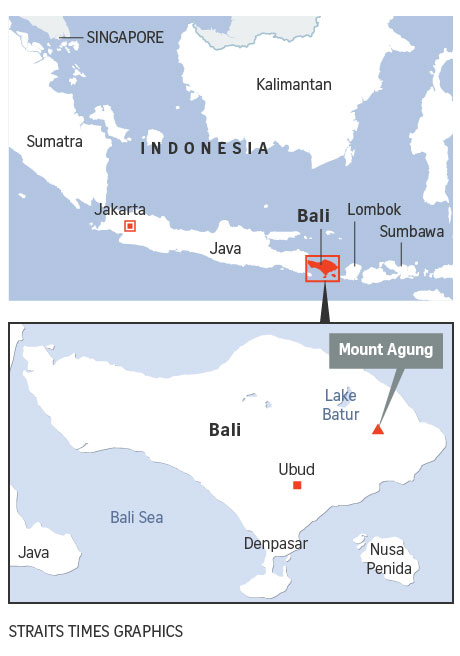KARANGASEM, Indonesia (AFP) - Thousands living in the shadow of Bali's rumbling volcano Mount Agung fled on Wednesday (Nov 22) as fears grow that it could unleash the first major eruption in more than 50 years.
Mount Agung belched smoke as high as 700 metres above its summit late Tuesday afternoon, sparking an exodus from the settlements near the mountain.
Nearly 1,600 people died when Mt Agung last erupted in 1963, triggering lava flows and sending huge columns of debris and ash into the atmosphere.
It stirred to life again in September, prompting about 140,000 people to leave the area. Many returned home after the volcano's activity waned, but thousands are now fleeing again.
Some 30,000 people remain displaced in 278 shelters, officials said.
"There are 13 of us and we're afraid. Our neighbours have also fled," said Nyoman Sadi, a local resident who said she was leaving with her family.
Disaster officials have warned that fresh activity at Mt. Agung could see it blow its top.
But the head of Indonesia's volcanology centre urged people to remain calm and said the mountain's alert level has not yet been raised. The volcano's alert level was still kept at level 3 on Tuesday, as the authorities said there had not been any increase in seismic activity.
"Yesterday there was smoke and steam as high as 700 metres, and last night there were tremors for quite a while - around three hours," Kasbani, who like many Indonesians goes by one name, told Agence France-Presse on Wednesday.
"The mountain continues to spew smoke, but there hasn't been any big eruption so far."
Mt. Agung lies 75km from Bali's main tourist areas, which attract millions of tourists every year.
Flights have not been affected so far, but officials have estimated that concerns about an eruption over the past few months have cost the island at least US$110 million (S$149 million) in lost tourism and productivity as many locals moved to shelters.
On Tuesday, Indonesia's National Disaster Mitigation Agency (BNPB) described the eruption as "phreatic", which is a steam-driven explosion that occurs when water beneath the ground or on the surface is heated by molten rock, known as magma, lava, hot rocks or new volcanic deposits, according to the Sydney Morning Herald.

Indonesia lies on the Pacific "Ring of Fire", where tectonic plates collide, causing frequent volcanic and seismic activities.
In 2010, Mount Merapi on the island of Java - considered one of the most active and dangerous volcanoes in the world - erupted after rumbling since 2006, killing more than 300 people and forcing 280,000 to flee.
Mount Sinabung on Sumatra island - which is currently at its highest alert level - has been active since 2013.

